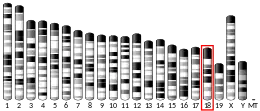PCDHA12
Protocadherin alpha-12 is a protein that in humans is encoded by the PCDHA12 gene.[5][6]
| PCDHA12 | |||||||||||||||||||||||||
|---|---|---|---|---|---|---|---|---|---|---|---|---|---|---|---|---|---|---|---|---|---|---|---|---|---|
| Identifiers | |||||||||||||||||||||||||
| Aliases | PCDHA12, PCDH-ALPHA12, protocadherin alpha 12 | ||||||||||||||||||||||||
| External IDs | OMIM: 606318 MGI: 1298408 HomoloGene: 135720 GeneCards: PCDHA12 | ||||||||||||||||||||||||
| |||||||||||||||||||||||||
| |||||||||||||||||||||||||
| |||||||||||||||||||||||||
| Orthologs | |||||||||||||||||||||||||
| Species | Human | Mouse | |||||||||||||||||||||||
| Entrez | |||||||||||||||||||||||||
| Ensembl | |||||||||||||||||||||||||
| UniProt | |||||||||||||||||||||||||
| RefSeq (mRNA) | |||||||||||||||||||||||||
| RefSeq (protein) | |||||||||||||||||||||||||
| Location (UCSC) | Chr 5: 140.88 – 141.01 Mb | Chr 18: 37.01 – 37.19 Mb | |||||||||||||||||||||||
| PubMed search | [3] | [4] | |||||||||||||||||||||||
| Wikidata | |||||||||||||||||||||||||
| |||||||||||||||||||||||||
This gene is a member of the protocadherin alpha gene cluster, one of three related gene clusters tandemly linked on chromosome 5 that demonstrate an unusual genomic organization similar to that of B-cell and T-cell receptor gene clusters. The alpha gene cluster is composed of 15 cadherin superfamily genes related to the mouse CNR genes and consists of 13 highly similar and 2 more distantly related coding sequences. The tandem array of 15 N-terminal exons, or variable exons, are followed by downstream C-terminal exons, or constant exons, which are shared by all genes in the cluster. The large, uninterrupted N-terminal exons each encode six cadherin ectodomains while the C-terminal exons encode the cytoplasmic domain. These neural cadherin-like cell adhesion proteins are integral plasma membrane proteins that most likely play a critical role in the establishment and function of specific cell-cell connections in the brain. Alternative splicing has been observed and additional variants have been suggested but their full-length nature has yet to be determined.[6]
References
- GRCh38: Ensembl release 89: ENSG00000251664 - Ensembl, May 2017
- GRCm38: Ensembl release 89: ENSMUSG00000007440 - Ensembl, May 2017
- "Human PubMed Reference:". National Center for Biotechnology Information, U.S. National Library of Medicine.
- "Mouse PubMed Reference:". National Center for Biotechnology Information, U.S. National Library of Medicine.
- Wu Q, Maniatis T (Jul 1999). "A striking organization of a large family of human neural cadherin-like cell adhesion genes". Cell. 97 (6): 779–90. doi:10.1016/S0092-8674(00)80789-8. PMID 10380929. S2CID 6014717.
- "Entrez Gene: PCDHA12 protocadherin alpha 12".
Further reading
- Yagi T, Takeichi M (2000). "Cadherin superfamily genes: functions, genomic organization, and neurologic diversity". Genes Dev. 14 (10): 1169–80. doi:10.1101/gad.14.10.1169 (inactive 2021-01-14). PMID 10817752.CS1 maint: DOI inactive as of January 2021 (link)
- Nollet F, Kools P, van Roy F (2000). "Phylogenetic analysis of the cadherin superfamily allows identification of six major subfamilies besides several solitary members". J. Mol. Biol. 299 (3): 551–72. doi:10.1006/jmbi.2000.3777. PMID 10835267.
- Martineau J, Barthélémy C, Jouve J, et al. (1992). "Monoamines (serotonin and catecholamines) and their derivatives in infantile autism: age-related changes and drug effects". Developmental Medicine & Child Neurology. 34 (7): 593–603. doi:10.1111/j.1469-8749.1992.tb11490.x. PMID 1380929. S2CID 28807066.
- Sugino H, Hamada S, Yasuda R, et al. (2000). "Genomic organization of the family of CNR cadherin genes in mice and humans". Genomics. 63 (1): 75–87. doi:10.1006/geno.1999.6066. PMID 10662547.
- Wu Q, Maniatis T (2000). "Large exons encoding multiple ectodomains are a characteristic feature of protocadherin genes". Proc. Natl. Acad. Sci. U.S.A. 97 (7): 3124–9. Bibcode:2000PNAS...97.3124W. doi:10.1073/pnas.060027397. PMC 16203. PMID 10716726.
- Wu Q, Zhang T, Cheng JF, et al. (2001). "Comparative DNA sequence analysis of mouse and human protocadherin gene clusters". Genome Res. 11 (3): 389–404. doi:10.1101/gr.167301. PMC 311048. PMID 11230163.
- Strausberg RL, Feingold EA, Grouse LH, et al. (2003). "Generation and initial analysis of more than 15,000 full-length human and mouse cDNA sequences". Proc. Natl. Acad. Sci. U.S.A. 99 (26): 16899–903. doi:10.1073/pnas.242603899. PMC 139241. PMID 12477932.
- Schmutz J, Martin J, Terry A, et al. (2004). "The DNA sequence and comparative analysis of human chromosome 5". Nature. 431 (7006): 268–74. Bibcode:2004Natur.431..268S. doi:10.1038/nature02919. PMID 15372022. S2CID 4373053.
- Otsuki T, Ota T, Nishikawa T, et al. (2007). "Signal sequence and keyword trap in silico for selection of full-length human cDNAs encoding secretion or membrane proteins from oligo-capped cDNA libraries". DNA Res. 12 (2): 117–26. doi:10.1093/dnares/12.2.117. PMID 16303743.



